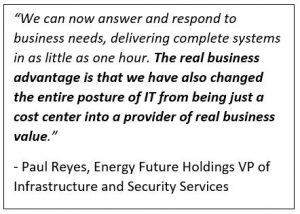
Here’s a prediction for 2018: Business will continue to get more complicated and every enterprise or government agency will have competitors investing in business transformation. There is a wealth of data that suggests business transformation will play a role in sorting out winners from ‘also rans’. While new technology plays a key role in modernizing infrastructure for both on premises and public cloud-based offerings, transformation is about much more than hardware and software. A number of recent studies provide useful guidance for 2018 decision making with respect to modernizing IT operations in support of transformation initiatives.
Leaders and Laggards
A Forbes global survey of 500 C-level executives concluded that “there’s a large gap between transformation leaders and their less advanced peers”. Leaders, companies, whose sales and profits had grown by 7% or more, have IT leaders with tighter ties to the business, more advanced IT transformation strategies, and achieve faster ROI for IT transformation.
At Dell, we embrace a Modernize, Automate, Transform (MAT) strategy both for our own IT strategy and for customers. At the highest level, this can be explained as a strategy to modernize IT infrastructure by leveraging the latest and most advanced technologies, automating IT processes through advanced software capabilities, and transforming organizations, business processes and skill sets through education, training and services. Increasingly, these strategies are predicated on a foundation of converged and hyper-converged (CI/HCI) infrastructure, and we observe that organizations getting the most value from their CI and HCI investments saw the need to transform from an organization that managed infrastructure components in silos to one that manages infrastructure more holistically. They built an IT Services model that delivers more business agility and improved business outcomes. They drove operational change and developed mechanisms for measuring business outcomes. As a result, they have achieved much higher ROI.
Becoming a Leader
This approach isn’t all that surprising. You’ve heard it before. You need to change people, process, and technology to achieve value. It takes time to do that, so you should not expect immediate results. However, when ESG analyzed the correlation between IT maturity and a range of business outcomes, they found that IT metrics improved at each stage of IT maturity. The positive correlation held for KPIs ranging from projects completed ahead of schedule to over achievement of revenue goals. ESG further reported that IT organizations implementing self-service portals are freed up from more mundane tasks to focus on business priorities.
That‘s good news!
An IT service orientation results in better organizational alignment and business outcomes, as shown by an IDC study, based on a survey of over 2500 senior managers and executives. It concluded that “enterprises in which the IT organization has a strong service orientation reported a 100% greater increase in bookings, a nearly 80% greater increase in inventory turns, and a 140% greater improvement in employee time spent serving customers”. But there is more to it. IDC reports that, over 3 years, “enterprises in which the IT organization works proactively with the business” reported:
- 50% greater improvement in compliance-related activities
- 80% greater growth in revenue from established product lines
- 90% greater growth in revenue from new product lines.”
Chargeback mechanisms can aid in the process. IDC reports that implementing chargeback mechanisms enables the business to ensure that IT expense is aligned with business priorities. Companies that implemented chargeback report increases in employee productivity and improvement in profit margin.
Measuring Results
 It is important to set expectations and establish an ongoing process for reviewing progress. You will want to have a plan to evolve organizational roles, structures and processes, and for measuring progress at each step as the IT organization matures.
It is important to set expectations and establish an ongoing process for reviewing progress. You will want to have a plan to evolve organizational roles, structures and processes, and for measuring progress at each step as the IT organization matures.
Metrics should address both financial and non-financial goals to enable IT to demonstrate support of strategic initiatives.
As the organization matures, focus especially on the metrics that matter most to the business. These might include time to roll out new applications, or the headcount required to support application growth. Begin with a baseline and plan on developing measurements that, while not precise, will indicate whether you are on the right track or whether a course correction is needed.
Charting and Staying the Course
IT investment can drive the business but it is essential to evaluate and measure the benefits. My recent blog, A Business Value Approach to IT Investing, offers sound advice for those evaluating a new investment. The Customer Value Program can help you create the baseline measurements for your organization, monitor and report on progress, and commit to continuous improvement.
In addition, Dell offers a portfolio of services to help you accelerate time to value and optimize business outcomes. Our expertise is based on work with successful companies and with our own data center transformation. Whether you want get a jump on organizing for success, or need some assistance as you get started, we are ready to help you improve business outcomes.